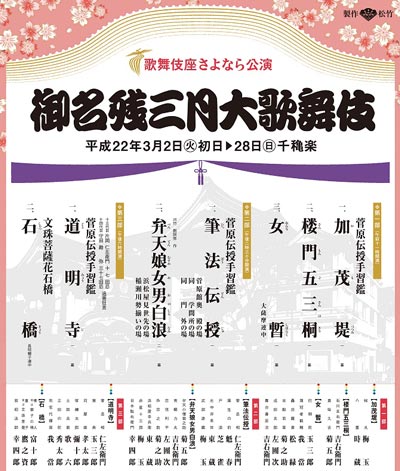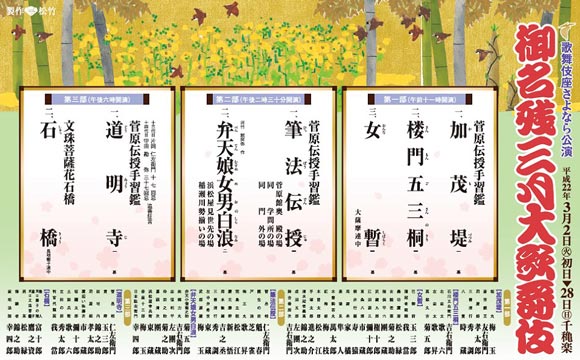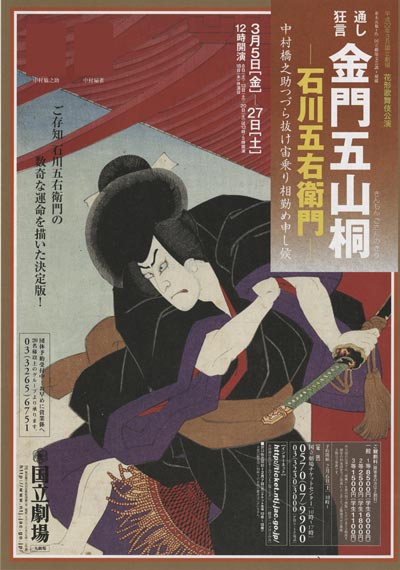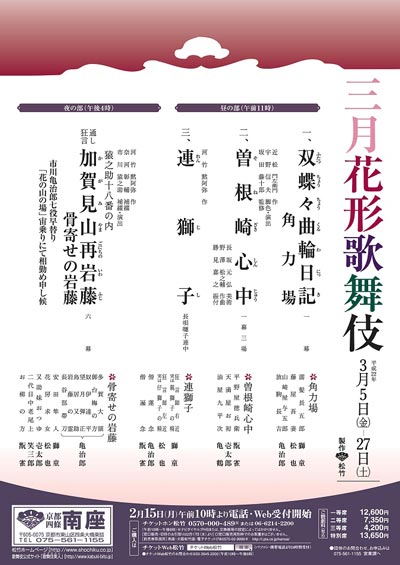| Comments |
15th of the 16 Kabukiza Sayonara K˘en, the Kabukiza Farewell Performances, which will be held up to April 2010.
This month program features three sections of "Sugawara Denju Tenarai Kagami" ("Sugawara and the Secrets of Calligraphy").
This is a very long play about Sugawara no Michizane (known in this play as Kan Sh˘j˘),
a high-ranking imperial court minister who was a brilliant calligrapher and scholar.
Political rivalries forced him to be exiled to distant Kyűshű, where he died.
But after Michizaneĺs death, he became revered as the god of learning.
Kamo Zutsumi:
(The Kamo Riverbank)
1st section of "Sugawara Denju Tenarai Kagami".
Young Sakuramaru (Nakamura Baigyoku) serves imperial prince Tokiyo who has fallen in love with Princess
Kariya, Michizaneĺs beautiful daughter. Sakuramaru and his wife Yae (Nakamura Tokiz˘) are charmed
by the affair, since it reminds them of their own love. But the affair is discovered
and Michizaneĺs rivals use it as proof that he is attempting to take over the
imperial court. This innocent love affair triggers the tragedies of the play.
Sanmon: though short, this play is one of the most visually spectacular
in Kabuki. The famous villain Ishikawa Goemon (Nakamura Kichiemon) enjoys a sea of cherry blossoms
while sitting on top the large gate of Nanzenji Temple. His enjoyment of the scene
is cut short, though, by the appearance below of his arch-nemesis, the general
Mashiba Hisayoshi (Onoe Kikugor˘).
Onna Shibaraku: more ceremony than play, "Shibaraku"
is one of the oldest pieces in Kabuki. Just as an evil villain is about to execute
a group of loyal retainers, a voice calls out for him to wait and a hero
appears to save the day. This version is a parody, though, as the hero
is played by an onnagata
female role specialist, who mixes the super-human strength of an
aragoto
hero with the soft gentleness of a Kabuki heroine. Featuring Band˘ Tamasabur˘ as
the heroine and Kataoka Gat˘ as the larger-than-life villain,
with Nakamura Kichiemon as a friendly stage attendant who makes sure that
everything goes right.
Hipp˘ Denju:
2nd section of "Sugawara Denju Tenarai Kagami".
Michizane, in this play called Kan Sh˘j˘ (Kataoka Nizaemon), after his title,
knows that he will soon be exiled. Before he goes, he hands over the scroll of his
secrets to his most talented student Genz˘ (Nakamura Baigyoku). But Genz˘ was disowned forever for
having an affair with Tonami (Nakamura Shibajaku), another servant in the household. Only the intervention
of Kan Sh˘j˘ĺs wife Sonoo-no-Mae (Nakamura Kaishun) saved their lives. Even though Genz˘ receives his
masterĺs teachings, he is not forgiven. Sugawara is arrested, but as Genz˘ and his
wife leave, they rescue Kan Sh˘j˘ĺs young son and take him to safety.
Benten Musume: this play is a sewamono (realistic play about commoners)
written by the late 19th century playwright Mokuami who is famous for his plays about thieves.
The thief Benten Koz˘ dresses up as a woman to commit extortion, but his plans are ruined when his disguise is seen through.
In the highlight of the play, he undresses, showing his colorful tattoos and introduces himself in a famous poetic speech.
Afterwards, he is joined by the members of his gang on a riverbank, and,
using the playwright's famous poetic rhythms, in turn, they each boast of their careers as thieves.
Onoe Kikugor˘ stars as Benten Koz˘, with Matsumoto K˘shir˘ as Nippon Daemon, Nakamura Kichiemon as Nang˘ Rikimaru,
Ichikawa Sadanji as Tadanobu Rihei and Nakamura Baigyoku as Akaboshi Jűzabur˘.
D˘my˘ji:
3rd section of "Sugawara Denju Tenarai Kagami".
On his way to exile, Kan Sh˘j˘ (Kataoka Nizaemon) is allowed to stop at the home of his aunt,
Kakuju (Band˘ Tamasabur˘). There he carves a statue of himself for his aunt.
But Princess Kariya (Kataoka Takatar˘) is actually Kakuju's daughter and was
adopted by Kan Sh˘j˘. She has come desperately hoping to say farewell
to him, but she is punished severely by Kakuju for having been responsible
for Kan Sh˘j˘'s downfall. At the same time, Kakuju has another daughter,
Tatsuta (Kataoka Hidetar˘) and Tatsuta's husband Sukune Tar˘ (Band˘ Yajűr˘) and
father-in-law (Nakamura Karoku) are plotting to assassinate Kan Sh˘j˘ by
pretending to be the emissary to take him to exile and then killing him.
But miraculously, the statue Kan Sh˘j˘ carved comes to life and saves
his life. Finally, when the real emissary Terukuni (Kataoka Gat˘) appears,
Kan Sh˘j˘ must part from his family as he goes into exile.
Shakky˘:
(The Stone Bridge)
There are many plays about shishi or lion
spirits in the Asian tradition, but the shishi is not
actually a lion, it is a mythical animal that guards the stone bridge (Shakky˘)
leading to the Buddhist paradise of Monju, the god of wisdom.
Featuring Nakamura Tomijűr˘, his young son Takanosuke and Matsumoto K˘shir˘.
Source: Earphone Guide website
|




